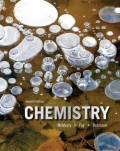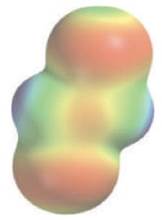
EBK CHEMISTRY
7th Edition
ISBN: 8220101360618
Author: Robinson
Publisher: YUZU
expand_more
expand_more
format_list_bulleted
Concept explainers
Textbook Question
Chapter 8, Problem 8.41CP
Two dichioroethylene molecules with the same chemical formula

cis 1,2 dichioroethylene trans 1,2 dichioroethylene
(a) Match each form of dichloroethylene to its electrostatic potential map.
(b) Which form of dichloroethylene has a dipole moment of 2.39 D and which has dipole moment of 0.00 D?
(c) Which form of dichloroethylene has the highest boiling point?
Expert Solution & Answer
Want to see the full answer?
Check out a sample textbook solution
Students have asked these similar questions
Propylene, C3H6, is a gas that is used to form the importantpolymer called polypropylene. Its Lewis structure is given. (a) What is the total number of valence electrons in the propylenemolecule? (b) How many valence electrons are usedto make σ bonds in the molecule? (c) How many valenceelectrons are used to make π bonds in the molecule? (d) Howmany valence electrons remain in nonbonding pairs in themolecule? (e) What is the hybridization at each carbon atomin the molecule?
2(a) Provide the Lewis structures for both CH3OH and C2H3Cl. 2(b) What is the largest bond angle among all the bond angles in CH3OH and C2H3Cl? Listthe three atoms making this largest bond angle, and estimate the value of the angle.2(c) What intermolecular forces are present(i) between CH3OH molecules?(ii) between C2H3Cl molecules?
The structural formulas for ethanol, CH3CH2OH, and propene,
CH;CH=CH,2, are
нн
H
Н—С—С—0—н
H-C-C=C-H
нн
H H H
Ethanol
Propene
(a) Complete the Lewis structure for each molecule showing all valence
electrons.
(b) Using the VSEPR model, predict all bond angles in each molecule.
Chapter 8 Solutions
EBK CHEMISTRY
Ch. 8 - Prob. 8.1PCh. 8 - Prob. 8.2ACh. 8 - PRACTICE 8.3 Acetic acid, CH3CO2H , is the main...Ch. 8 - APPLY 8.4 Benzene, C6H6 , is a cyclic molecule in...Ch. 8 - PRACTICE 8.5 Identify the orbitals that overlap to...Ch. 8 - APPLY 8.6 Describe the bonding in propane, C3H8 ,...Ch. 8 - PRACTICE 8.7 Describe the hybridization of the...Ch. 8 - APPLY 8.8 Describe the hybridization of each...Ch. 8 - PRACTICE 8.9 Describe the hybridization of the...Ch. 8 - APPLY 8.10 Describe the hybridization of the...
Ch. 8 - Prob. 8.11PCh. 8 - Conceptual APPLY 8.12 Match the following...Ch. 8 - Prob. 8.13PCh. 8 - Prob. 8.14ACh. 8 - Prob. 8.15PCh. 8 - Prob. 8.16ACh. 8 - Prob. 8.17PCh. 8 - Prob. 8.18ACh. 8 - Prob. 8.19PCh. 8 - Prob. 8.20ACh. 8 - Prob. 8.21PCh. 8 - Prob. 8.22ACh. 8 - PRACTICE 8.23 Draw two resonance structures for...Ch. 8 - APPLY 8.24 Draw two resonance structures for the...Ch. 8 - Prob. 8.25PCh. 8 - Prob. 8.26PCh. 8 - PROBLEM 8.27 Identify which of the following...Ch. 8 - Prob. 8.28PCh. 8 - Prob. 8.29PCh. 8 - Prob. 8.30PCh. 8 - Prob. 8.31CPCh. 8 - Prob. 8.32CPCh. 8 - Prob. 8.33CPCh. 8 - Prob. 8.34CPCh. 8 - Prob. 8.35CPCh. 8 - Prob. 8.36CPCh. 8 - Prob. 8.37CPCh. 8 - Prob. 8.38CPCh. 8 - Prob. 8.39CPCh. 8 - Prob. 8.40CPCh. 8 - Two dichioroethylene molecules with the same...Ch. 8 - Prob. 8.42SPCh. 8 - Prob. 8.43SPCh. 8 - Prob. 8.44SPCh. 8 - How many charge clouds are there around the...Ch. 8 - Prob. 8.46SPCh. 8 - Prob. 8.47SPCh. 8 - What shape do you expect for each of the following...Ch. 8 - Prob. 8.49SPCh. 8 - Prob. 8.50SPCh. 8 - Prob. 8.51SPCh. 8 - Prob. 8.52SPCh. 8 - Prob. 8.53SPCh. 8 - Acrylonitrile is used as the starting material for...Ch. 8 - Predict values for all bond angles in dimethyl...Ch. 8 - Oceanographers study the mixing of water masses by...Ch. 8 - Prob. 8.57SPCh. 8 - Prob. 8.58SPCh. 8 - Prob. 8.59SPCh. 8 - Prob. 8.60SPCh. 8 - Prob. 8.61SPCh. 8 - Prob. 8.62SPCh. 8 - Prob. 8.63SPCh. 8 - Prob. 8.64SPCh. 8 - Prob. 8.65SPCh. 8 - Oxaloacetic acid is an intermediate involved in...Ch. 8 - The atoms in the amino acid glycine are connected...Ch. 8 - Prob. 8.68SPCh. 8 - Prob. 8.69SPCh. 8 - Prob. 8.70SPCh. 8 - 8.71 What is the difference between London...Ch. 8 - 8.72 What are the most important kinds of...Ch. 8 - Of the substances Xe,CH3Cl,HF, which has: (a) The...Ch. 8 - 8.74 Methanol boils nearlyhigher than methane, but...Ch. 8 - Prob. 8.75SPCh. 8 - Prob. 8.76SPCh. 8 - Prob. 8.77SPCh. 8 - Prob. 8.78SPCh. 8 - Prob. 8.79SPCh. 8 - Prob. 8.80SPCh. 8 - 8.81 Draw three-dimensional structures of PCl3 and...Ch. 8 - Prob. 8.82SPCh. 8 - Prob. 8.83SPCh. 8 - Prob. 8.84SPCh. 8 - Prob. 8.85SPCh. 8 - 8.86 A liquid sample contains methylamine (CH3NH2)...Ch. 8 - Prob. 8.87SPCh. 8 - Prob. 8.88SPCh. 8 - Prob. 8.89SPCh. 8 - Prob. 8.90SPCh. 8 - Prob. 8.91SPCh. 8 - Prob. 8.92SPCh. 8 - Prob. 8.93SPCh. 8 - Prob. 8.94SPCh. 8 - Prob. 8.95SPCh. 8 - Prob. 8.96SPCh. 8 - Prob. 8.98CPCh. 8 - Prob. 8.99CPCh. 8 - Prob. 8.100CPCh. 8 - Prob. 8.101CPCh. 8 - Prob. 8.102CPCh. 8 - Prob. 8.103CPCh. 8 - Prob. 8.104CPCh. 8 - Prob. 8.105CPCh. 8 - Prob. 8.106CPCh. 8 - Prob. 8.107CPCh. 8 - Prob. 8.108CPCh. 8 - Prob. 8.109CPCh. 8 - The odor of cinnamon oil is due to cinnamaldehyde,...Ch. 8 - Prob. 8.111CPCh. 8 - Prob. 8.112CPCh. 8 - Prob. 8.113CPCh. 8 - Prob. 8.114CPCh. 8 - Prob. 8.115CPCh. 8 - Prob. 8.116CPCh. 8 - Prob. 8.117CPCh. 8 - Prob. 8.118CPCh. 8 - Prob. 8.119MPCh. 8 - Prob. 8.120MPCh. 8 - Prob. 8.121MP
Knowledge Booster
Learn more about
Need a deep-dive on the concept behind this application? Look no further. Learn more about this topic, chemistry and related others by exploring similar questions and additional content below.Similar questions
- Following are the structures of three isomers of difluorobenzene, C6H4F2. Are any of them nonpolar?arrow_forwardConsider the following molecules: SiH4, PH3, H2S. In each case, a central atom is surrounded by four electron pairs. In which of these molecules would you expect the bond angle to be less than 109.5? Explain your reasoning.arrow_forwardIn addition to CO, CO2, and C3O2, there is another molecular oxide of carbon, pentacarbon dioxide, C5O2, a yellow solid. (a) What is the approximate C-to-C-to-O bond angle in pentacarbon dioxide? (b) What is the approximate C-to-C-to-C bond angle in this compound?arrow_forward
- Methyl isocyanate, CH3NCO, was made infamous in 1984when an accidental leakage of this compound from a storagetank in Bhopal, India, resulted in the deaths of about3800 people and severe and lasting injury to many thousandsmore. (a) Draw a Lewis structure for methyl isocyanate.(b) Draw a ball-and-stick model of the structure,including estimates of all the bond angles in the compound.(c) Predict all the bond distances in the molecule.(d) Do you predict that the molecule will have a dipolemoment? Explain.arrow_forwardTwo important industrial chemicals, ethene, C2H4, and propene, C3H6, are produced by the steam (or thermal) cracking process: 2C3H8(g) = C2H4(g) + C3H6(g) + CH4(g) + H2(g) For each of the four carbon compounds, do the following: (a) Draw a Lewis Structure (b) Predict the geometry about the carbon atom (c) Determine the hybridization of each type of carbon atomarrow_forward(a) How does a polar molecule differ from a nonpolar one? (b) Atoms X and Y have different electronegativities. Will the diatomic molecule X—Y necessarily be polar? Explain. (c) What factors affect the size of the dipole moment of a diatomic molecule?arrow_forward
- Propylene, C3H6, is a gas that is used to form the importantpolymer called polypropylene. Its Lewis structure is (a) What is the total number of valence electrons in the propylenemolecule? (b) How many valence electrons are usedto make s bonds in the molecule? (c) How many valenceelectrons are used to make p bonds in the molecule? (d) Howmany valence electrons remain in nonbonding pairs in themolecule? (e) What is the hybridization at each carbon atomin the molecule?arrow_forwardOxalic acid, H2C2O4, a poisonous colorless solid, is found in some vegetables such as spinach and rhubarb. It is present in concentrations well below the toxic limit, so you can't use this as a reason to refuse a helping of spinach. The order of atoms in a molecule of oxalic acid is HO2CCO2H. (a) How many unshared pairs of electrons are on each of the carbon atoms? (b) How many unshared pairs of electrons are on each of the oxygen atoms?arrow_forwardIdentify the set that shows the correct trend in increasing polarity of covalent bonds: (A) B―F < C―F < C―Cl < N―Cl (B) C―F < C―Cl < N―Cl < B―F; (C) N―Cl < C―Cl < C―F < B―F; (D) C―Cl < N―Cl < B―F < C―F;arrow_forward
- (a) Methane (CH4) and the perchlorate ion (ClO4- ) are bothdescribed as tetrahedral. What does this indicate about theirbond angles? (b) The NH3 molecule is trigonal pyramidal, while BF3 is trigonal planar. Which of these molecules is flat?arrow_forwardThe structure of caffeine is shown below. (a) Complete the Lewis structure. (b) How many pi bonds are present in caffeine? How many sigma bonds? (c) Identify the hybridization of the carbon atoms. (d) What is the value of the O-C-N angle?arrow_forwardindicate the approximate values for the indicated bond angles in the following molecules. 1 (a) H 0-N=ö 2. Н 4 H. (b) H C-c=0 H H H (c) H-N-O–H . H. (d) H-C-C=N: H.arrow_forward
arrow_back_ios
SEE MORE QUESTIONS
arrow_forward_ios
Recommended textbooks for you
 Chemistry: Principles and ReactionsChemistryISBN:9781305079373Author:William L. Masterton, Cecile N. HurleyPublisher:Cengage Learning
Chemistry: Principles and ReactionsChemistryISBN:9781305079373Author:William L. Masterton, Cecile N. HurleyPublisher:Cengage Learning Chemistry: The Molecular ScienceChemistryISBN:9781285199047Author:John W. Moore, Conrad L. StanitskiPublisher:Cengage Learning
Chemistry: The Molecular ScienceChemistryISBN:9781285199047Author:John W. Moore, Conrad L. StanitskiPublisher:Cengage Learning Chemistry: Principles and PracticeChemistryISBN:9780534420123Author:Daniel L. Reger, Scott R. Goode, David W. Ball, Edward MercerPublisher:Cengage Learning
Chemistry: Principles and PracticeChemistryISBN:9780534420123Author:Daniel L. Reger, Scott R. Goode, David W. Ball, Edward MercerPublisher:Cengage Learning

Chemistry: Principles and Reactions
Chemistry
ISBN:9781305079373
Author:William L. Masterton, Cecile N. Hurley
Publisher:Cengage Learning

Chemistry: The Molecular Science
Chemistry
ISBN:9781285199047
Author:John W. Moore, Conrad L. Stanitski
Publisher:Cengage Learning

Chemistry: Principles and Practice
Chemistry
ISBN:9780534420123
Author:Daniel L. Reger, Scott R. Goode, David W. Ball, Edward Mercer
Publisher:Cengage Learning
Stoichiometry - Chemistry for Massive Creatures: Crash Course Chemistry #6; Author: Crash Course;https://www.youtube.com/watch?v=UL1jmJaUkaQ;License: Standard YouTube License, CC-BY
Bonding (Ionic, Covalent & Metallic) - GCSE Chemistry; Author: Science Shorts;https://www.youtube.com/watch?v=p9MA6Od-zBA;License: Standard YouTube License, CC-BY
General Chemistry 1A. Lecture 12. Two Theories of Bonding.; Author: UCI Open;https://www.youtube.com/watch?v=dLTlL9Z1bh0;License: CC-BY

